M Series Connectors
Are lightweight triplestart ratchet coupling type connectors designed for avionics, aerospace, Harsh Environment Connectors, security, motorsport and heavy duty applications.
While the internet of things (IoT) is commonly observed in everyday consumer devices, the Industrial Internet of Things (IIoT) encompasses a vast landscape. Its applications predominantly thrive in business, factory, and healthcare environments. Interestingly, over one-third of the nearly $6 trillion IoT market is attributed to the manufacturing sector.
Connectivity serves as the fundamental pillar of the IIoT, enabling the vital transmission of power and data for controlling mechanisms, devices, machines, and the cloud, facilitating the execution of IIoT functionalities. Additionally, wireless communication-enabled components, Ethernet-based networks, open-source programming, software in the form of unifying development environments (UDEs) to foster large-scale interoperability, and standardized protocols, cables, and connector options further contribute to the evolving landscape.
In this article, we delve into two key connectivity criteria. They play a crucial role in today’s motion control systems: the M12 connector and Power over Ethernet (PoE). A third, related standard, Single Pair Ethernet (SPE), is also briefly introduced as another means of simplifying automation processes.
Let’s dive into the significance of the X-coded M12 connector used in NEMA-14 stepper motors with closed-loop current control. These motors are connected via Power over Ethernet (PoE). With the advent of high power standards for industrial Ethernet switches, the challenge of providing enough power to power the motors is gradually getting solved.
M8 and M12 connectors are reliable round cable terminations that connect automation devices to large systems and fieldbus networks. These connectors significantly reduce installation time compared to traditional hard-wired designs. It is possible to eliminate the need to hire an electrician to install automated machines, simplifying the implementation process.
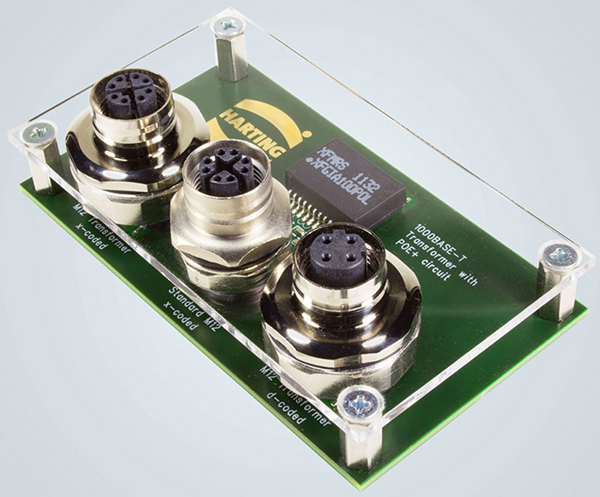
M8 and M12 connectors, along with sheathed cables, simplify procedures. The origin of these connectors is a proprietary 7/8-inch three-pin connector released in 1982. It has a free-rotating housing known as a coupling nut. This design is the same as most modern M8 and M12 connectors. Attaching the external coupling nut securely to the male socket of the device ensures a reliable connection and mechanical shielding against dust and liquids.
Today, M8 connectors are widely used to connect industrial sensors, actuators, switches, PLCs and I/O modules to various automation systems. On the other hand, M12 connectors are used in a wide range of applications. These include factory automation, test and measurement, food and beverage, and robotics. They are available in three- or four-pin configurations, as well as five-, six-, eight- or twelve-pin versions to accommodate advanced sensors and actuators.
M12 connectors are excellent in harsh environments involving flushing procedures and exposure to corrosive substances. In fact, M12 connectors with IP65, IP67, IP68 and IP69K ratings are common. Ensuring that they do not leak even when submerged in water. This is one of the reasons they are so common in industries such as food and beverage, rubber and plastics, and textile and printing applications.
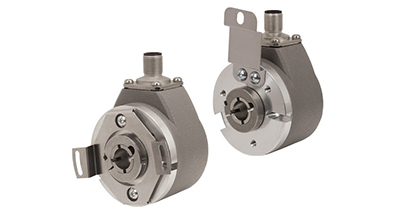
Most sensor and power applications require three- and four-pin M12 arrangements. PROFINET and Ethernet use four- and eight-pin quantities …… while most CANbus and DeviceNet connections use four- and five-pin quantities. In some cases, a twelve-pin configuration is required for specific signaling modes.
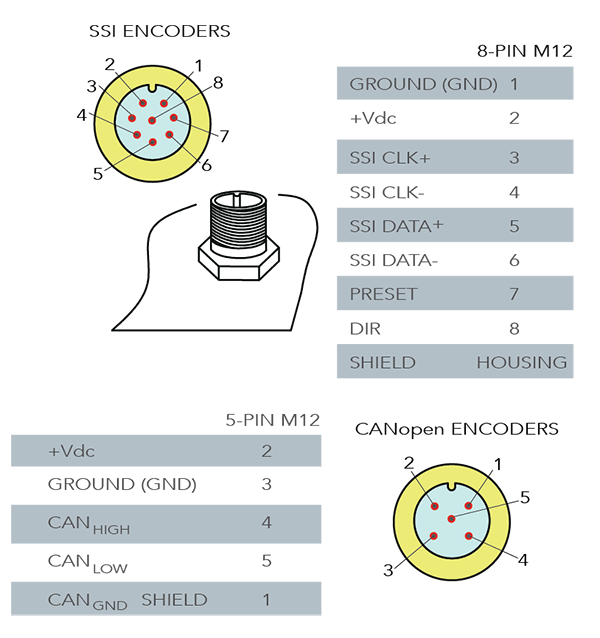
M12 connector coding is a standardized system that ensures the proper application of different connector types. The coding system helps to prevent incorrect mating and ensures compatibility between connectors and their corresponding devices.
Of these variants, the A, B and D connectors are the most common. This is because they are variants of the original M12 connectors. However, X-coded connectors are becoming increasingly popular, especially in high-speed industrial Ethernet applications. They can meet the requirements of CAT6A and support data transfer speeds of up to 10 Gb/s. X-coded connectors are gradually replacing A and D-coded M12 connectors for Ethernet applications.
In addition to these coding variations, there are also newer M12 connectors available. For example, the K-coded connector is designed for AC power applications. The L-coded connector is specifically developed for PROFINET DC power.
M12 connector designs, including straight and right-angle configurations, are standardized in IEC 61076-2-101. PVC and PUR sheathed cables are compatible with M12 connectors. A variety of custom options are also available, including shielded or unshielded cables, armored cables, and stainless steel connection nuts and assemblies. These options provide flexibility and allow for the adaptation of M12 connectors to specific application requirements.
Power over Ethernet (PoE) is a standardized networking arrangement that enables the transmission of data and electric power over twisted-pair Ethernet cables, such as Cat5e, Cat6, and Cat6a.
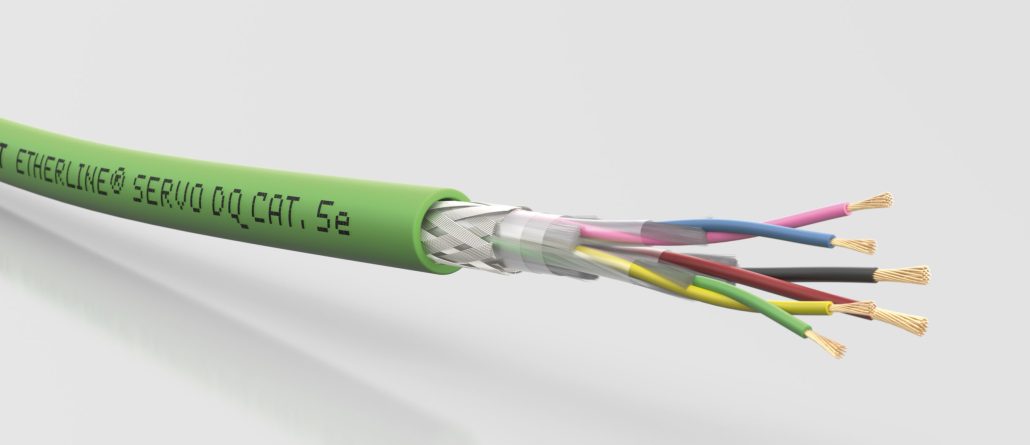
The IEEE has defined various versions of PoE that support different data transmission rates and power levels. These include:
While PoE is commonly associated with powering sensors, cameras, and other feedback devices, the adoption of 802.3at PoE+ (Type 2) is rapidly increasing in the motion control industry. This standard is particularly relevant to moderately sized motion control applications because it provides sufficient wattage to supply full power to electric motors used in motion axis actuation. In this context, the PoE powered devices (PDs) are the actuators that benefit from the power provided by PoE+ for their motion control operations.
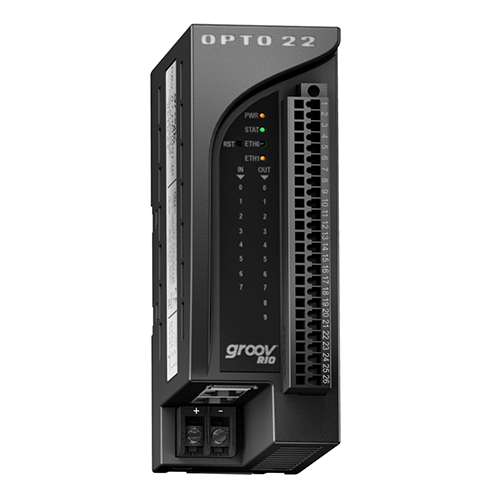
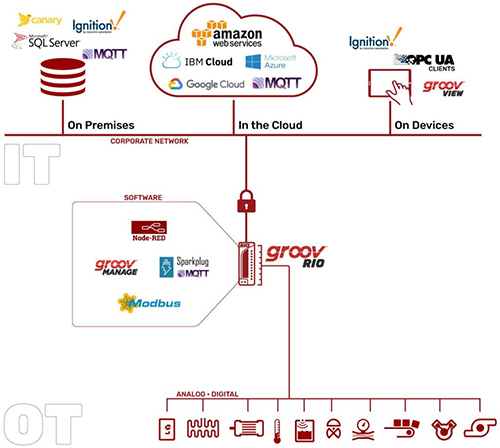
PoE eliminates the need to use AC power on remote devices, thus avoiding potentially dangerous electrical connections. By transferring data and power over Ethernet cables, PoE simplifies installation and improves safety.
Another benefit of PoE is the ability to easily connect and disconnect components for physical reconfiguration. This flexibility complements modern UDE and other software tools over traditional hardwired connections.
There are a few caveats: For each switch or hub in a PoE system, there is a power budget (the power of the switch divided by the number of ports used). In addition, any installation with non-PoE components (including separate power and data lead setups) requires one of two subcomponents:
1. Injectors: They are typically used to add PoE devices to an existing system. The injector will provide power to the PoE-compliant device and transmit data through the existing non-PoE switch. This method saves money and eliminates the need to purchase new PoE-enabled switches.
2. Splitters: They split power and data onto separate conductors to allow connection to non-PoE-compliant components.
One final caveat: PoE without a supplement can only carry signals up to 100 meters long on a given switch or hub. In installations with many PoE devices, compensating power supplies as well as (data signal) extenders may be required.
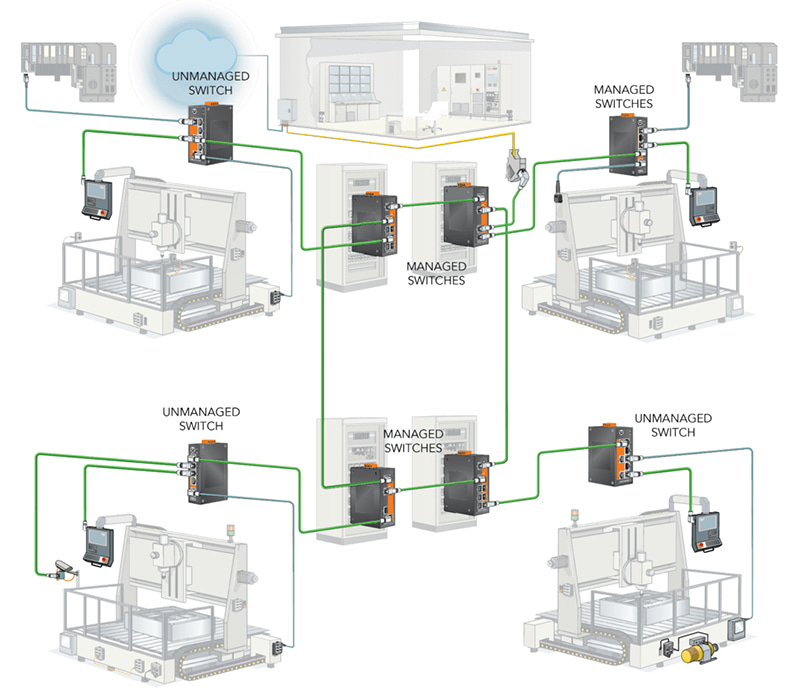
So far, we have detailed the use of standard four-wire pair (eight conductor) Ethernet for data connectivity and the relatively new adoption of PoE. Now, another Ethernet standard called Single Pair Ethernet (SPE) aims to go beyond the confusing fieldbuses on the market to simplify and improve the connectivity of field devices and controls.
SPE solves the limitations of the traditional Ethernet 100-meter transmission distance by enabling transmission distances of up to 1 km. This is useful for very large plant or automation setups as it provides greater coverage. SPE cables are only a quarter of the diameter and weight of traditional Ethernet cables. This is very useful in machinery with dense groups of field devices. Its small size and light weight make it easier to wire in limited spaces. As defined by the IEEE 802.3cg 10Mb/sec standard, SPE cannot achieve the standard four-pair Ethernet data rate. although 1Gb/sec can be achieved in industrial environments and SPE maintains all the built-in data security of the IEEE 802.3 standard.
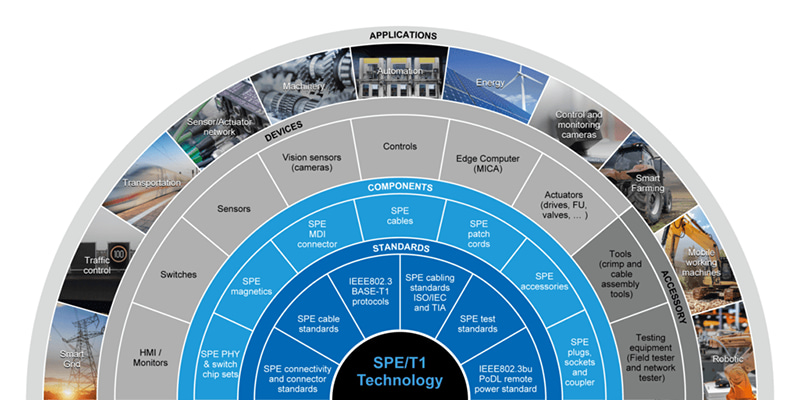
Please note that PoE and SPE are not mutually exclusive. SPE can transmit power and data by leveraging existing PoE standards in a Power over Data Line (PoDL) setup. Power distribution technology is standardized for 10Mb/sec twisted pair with power comparable to the IEEE 802.3af 15-W standard and above.